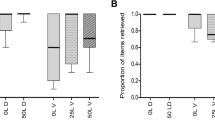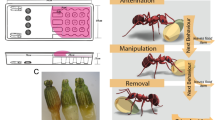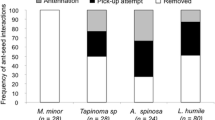Abstract
True myrmecochory involves the dispersal of elaiosome-bearing seeds by ants. Between the guild of ants that are attracted to these seeds, only a few of them will act as effective dispersers, that is, transporting the seeds to suitable sites (the nests) for germination and plant establishment. Ant communities are known to be highly hierarchical, and subordinate ants quickly deliver resources to their nest rather than consuming it on-site, thereby avoiding encounters with more dominant species. As a result of a series of studies that were carried out during summer in semi-arid Northwest Argentina, we have found that the most important seed disperser of the myrmecochorous plant Jatropha excisa Griseb. (Euphorbiaceae), the ant Pogonomyrmex cunicularius pencosensis Forel, was the most subordinate species during interspecific interactions. The daily timing of release of the J. excisa seeds through ballistic dispersal increased their probability of being removed by the highly thermophilic P. cunicularius pencosensis. Foraging during the warmest hours of the day allowed P. cunicularius pencosensis ants to avoid the risk of interference competition with dominant species, which also behaved as elaiosome predators. As a conclusion, subordinance behaviour appears to be integral to successful myrmecochory, and also the timing of seed release plays a key role in shaping the dynamics of myrmecochorous interactions. Therefore, ant-dispersed plants should not only favour their discovery by subordinate ants, but also should present their seeds at those times of the day when the behaviourally dominant ants are less active.





Similar content being viewed by others
References
Abraham E, del Valle HF, Roig F, Torres L, Coronato F, Godagnone R (2009) Overview of the geography of the Monte Desert biome (Argentina). J Arid Environ 73:144–153
Albrecht M, Gotelli N (2001) Spatial and temporal niche partitioning in grassland ants. Oecologia 126:134–141
Andersen AN (1995) A classification of Australian ant communities, based on functional groups which parallels plant life-forms in relation to stress and disturbance. J Biogeogr 22:15–29
Andersen AN (1997) Functional groups and patterns of organization in North American ant communities: a comparison with Australia. J Biogeogr 24:433–460
Aranda-Rickert A, Fracchia S (2010) Diplochory in two Jatropha (Euphorbiaceae) species of the Monte Desert of Argentina. Austral Ecol 35:226–235
Aranda-Rickert A, Fracchia S (2011) Pogonomyrmex cunicularius as the keystone disperser of the elaiosome-bearing Jatropha excisa seeds in semi-arid Argentina. Entomol Exp Appl 139:91–102
Beattie AJ (1985) The evolutionary ecology of ant-plant mutualisms. Cambridge University Press, New York
Bernstein RA (1974) Seasonal food abundance and foraging activity in some desert ants. Am Nat 108:490–498
Bestelmeyer BT (2000) The trade-off between thermal tolerance and behavioural dominance in a subtropical South American ant community. J Anim Ecol 69:998–1009
Boulay R, Carro F, Soriguer RC, Cerdá X (2007) Synchrony between fruit maturation and effective disperser’ foraging activity increases seed protection against seed predators. Proc R Soc B 274:2515–2522
Bronstein JL (1994) Conditional outcomes in mutualistic interactions. Trends Ecol Evol 9:214–217
Calcaterra LA, Livore JP, Delgado A, Briano JA (2008) Ecological dominance of the red imported fire ant, Solenopsis invicta in its native range. Oecologia 156:411–421
Cerdá X, Retana J, Cross S (1997) Thermal disruption of transitive hierarchies in Mediterranean ant communities. J Anim Ecol 66:363–374
Cerdá X, Retana J, Cross S (1998a) Critical thermal limits in Mediterranean ant species: trade-off between mortality risk and foraging performance. Funct Ecol 12:45–55
Cerdá X, Retana J, Manzaneda A (1998b) The role of competition by dominants and temperature in the foraging of subordinate species in Mediterranean ant communities. Oecologia 117:404–412
Cros S, Cerdá X, Retana J (1997) Spatial and temporal variations in the activity patterns of Mediterranean ant communities. ÉcoScience 4:269–278
Cuezzo F, Claver S (2009) Two new species of the ant genus Pogonomyrmex (Hymenoptera: Formicidae) from Argentina. Rev Soc Entomol Arg 68:97–106
Cushman JH, Beattie AJ (1991) Mutualisms-assessing the benefits to hosts and visitors. Trends Ecol Evol 6:193–195
Davidson DW (1998) Resource discovery versus resource domination in ants: a functional mechanism for breaking the trade-off. Ecol Ent 23:484–490
Espadaler X, Gómez C (1996) Seed production, predation and dispersal in the Mediterranean myrmecochore Euphorbia characias (Euphorbiaceae). Ecography 19:7–15
Fellers JH (1987) Interference and exploitation in a guild of woodland ants. Ecology 68:1466–1478
Fellers JH (1989) Daily and seasonal activity in woodland ants. Oecologia 78:69–76
Fernández F (2003) Introducción a las Hormigas de la Región Neotropical. Instituto Humboldt, Bogotá, Colombia
Garrido JL, Rey PJ, Cerdá X, Herrera CM (2002) Geographical variation in diaspore traits of an ant-dispersed plant (Helleborus foetidus): are ant community composition and diaspore traits correlated? J Ecol 90:446–455
Gehring WJ, Wehner R (1995) Heat shock protein synthesis and thermotolerance in Cataglyphis, an ant from the Sahara desert. Proc Natl Acad Sci USA 92:2994–2998
Giladi I (2006) Choosing benefits or partners: a review of the evidence for the evolution of myrmecochory. Oikos 112:481–492
Giliberto J, Gutiérrez JR, Hajek ER (1980) Temperature effect on autochory in Colliguaya odorifera (Euphorbiaceae). Int J Biometeorol 24:199–202
Gove AD, Majer JD, Dunn RR (2007) A keystone ant species promotes seed dispersal in a “diffuse” mutualism. Oecologia 153:687–697
Guitián J, Garrido JL (2006) Is early flowering in myrmecochorous plants an adaptation for ant dispersal? Plant Species Biol 21:165–171
Hanzawa FM, Beattie AJ, Culver DC (1988) Directed dispersal: demographic analysis of an ant-seed mutualism. Am Nat 131:1–13
Heithaus ER, Humes M (2003) Variation in communities of seed-dispersing ants in habitats with different disturbance in Know County, Ohio. Ohio J Sci 103:89–97
Herrera C (1995) Plant-vertebrate seed dispersal systems in the Mediterranean: ecological, evolutionary, and historical determinants. Annu Rev Ecol Syst 26:705–727
Hölldobler B, Wilson EO (1990) The ants. Belknap Press, Cambridge, MA
Irwin RE, Adler LS, Brody AK (2004) The dual role of floral traits: pollinator attraction and plant defense. Ecology 85:1503–1511
Kusnezov N (1963) Zoogeografía de las hormigas en Sudamérica. Acta Zool Lill 19:25–186
Kusnezov N (1978) Hormigas Argentinas. Clave para su Identificación. Miscelánea 61. Fundación Miguel Lillo, Tucumán, Argentina
Lanza J, Schmitt MA, Awad AB (1992) Comparative chemistry of elaiosomes of three species of Trillium. J Chem Ecol 18:209–221
Lourteig A, O’Donnell CA (1943) Euphorbiaceae Argentinae. Lilloa IX:77–143
Manzaneda AJ, Rey PJ (2009) Assessing ecological specialization of an ant-seed dispersal mutualism through a wide geographic range. Ecology 90:3009–3022
Marshall DL, Beattie AJ, Bollenbacher WE (1979) Evidence for diglycerides as attractants in an ant-seed interaction. J Chem Ecol 5:335–344
Ness JH, Morin DF (2008) Forest edges and landscape history shape interactions between plants, seed-dispersing ants and seed predators. Biol Conserv 141:838–847
Ness JH, Morin DF, Giladi I (2009) Uncommon specialization in a mutualism between a temperate herbaceous plant guild and an ant: are Aphaenogaster ants keystone mutualists? Oikos 118:1793–1804
Oberrath R, Böhning-Gaese K (2002) Phenological adaptations of ant-dispersed plants to seasonal variation in ant activity. Ecology 83:1412–1420
Ohkawara K, Higashi S, Ohara M (1996) Effects of ants, ground beetles and seed-fall patterns on the myrmecochory of Erythronium japonicum Decne. (Liliaceae-Tulipaeae). Oecologia 106:500–506
Ohkawara K, Ohara M, Higashi S (1997) The evolution of ant-dispersal in a spring-ephemeral Corydalis ambigua (Papaveraceae): timing of seed-fall and effects of ants and ground beetles. Ecography 20:217–223
R Development Core Team (2005) R: A language and environment for statistical computing. R Foundation for Statistical Computing, Vienna, Austria
Retana J, Cerdá X (2000) Patterns of diversity and composition of Mediterranean ground ant communities tracking spatial and temporal variability in the thermal environment. Oecologia 123:436–444
Rico-Gray V, Oliveira PS (2007) The ecology and evolution of ant-plant interactions. The University of Chicago Press, Chicago
Savolainen R, Vepsäläinen K (1988) A competition hierarchy among boreal ants: impact on resource partitioning and community structure. Oikos 51:135–155
Thompson JN (1981) Elaiosomes and fleshy fruits: phenology and selection pressures for ant-dispersed seeds. Am Nat 117:104–108
Thompson JN (1994) The coevolutionary process. The University of Chicago Press, Chicago
Turnbull CL, Culver DC (1983) The timing of seed dispersal in Viola nuttallii: attraction of dispersers and avoidance of predators. Oecologia 59:360–365
Vepsäläinen K, Savolainen R (1990) The effect of interference by formicine ants on the foraging of Myrmica. J Anim Ecol 59:643–654
Wilson EO (1971) The insect societies. Belknap Press, Cambridge, MA
Acknowledgments
This study is part of the Ph.D. dissertation of A. A. R. at the Universidad de Buenos Aires, Argentina, which was financially supported by a Consejo Nacional de Investigaciones Científicas y Tecnológicas Grant. Field work was assisted by Lucía Krapovickas and Félix Fracchia. We thank Robert Johnson for gently providing the key for the identification of the P. cunicularius subspecies, and the two anonymous reviewers for their helpful manuscript suggestions.
Author information
Authors and Affiliations
Corresponding author
Additional information
Handling editor: Jonathan Lundgren
Rights and permissions
About this article
Cite this article
Aranda-Rickert, A., Fracchia, S. Are subordinate ants the best seed dispersers? Linking dominance hierarchies and seed dispersal ability in myrmecochory interactions. Arthropod-Plant Interactions 6, 297–306 (2012). https://doi.org/10.1007/s11829-011-9166-z
Received:
Accepted:
Published:
Issue Date:
DOI: https://doi.org/10.1007/s11829-011-9166-z




